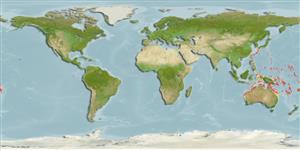>
Ophidiiformes (Cusk eels) >
Dinematichthyidae (Viviparous brotula)
Etymology: Alionematichthys: Name from Latin alius meaning the other or different, and nematichthys, the stem of the genus name Dinematichthys, to which this genus is most similar.; crassiceps: Named for the characteristic big head (Latin crassus for thick and the adjective ending derived from caput or head; noun in apposition..
More on authors: Møller & Schwarzhans.
Environment: milieu / climate zone / depth range / distribution range
Ecología
marino asociado a arrecife; rango de profundidad 0 - 5 m (Ref. 90102). Tropical
Eastern Indian Ocean: Western Australia (Ref. 88966). Western Pacific: along oceanic islands, from Micronesia (Palau, Chuuk, Pohnpei, Kapingamarangi Atoll), Hermit I., and the Kiriwina (Trobriand) Is., New Guinea, Vanuatu, Fiji to Tonga. Probable records from Taiwan (NW Pacific).
Tamaño / Peso / Age
Maturity: Lm ? range ? - ? cm
Max length : 6.3 cm SL macho / no sexado; (Ref. 81230)
Short description
Morfología | Morfometría
Radios blandos dorsales (total): 72-81; Radios blandos anales: 57 - 64; Vértebra: 41 - 43. This species is distinguished by the following characters: ; D 72-81; A 57-64; small eyes (1.3-2.5%SL); blunt snout, no cirri; cheeks with scales and 3-10 scales above opercular spine; with upper preopercular pore; outer pseudoclasper broad-based, simple flap like, while the inner one with free, forward-pointing anterior lobe and broad posterior lobe; otolith length to height 1.9-2.0, with rounded dorsal rim; otolith length to sulcus length 1.7-1.8, very short caudal, ostium length to cauda length 4.5-5.0 (Ref. 81230).
Cryptic, solitary inhabitant of shallow water, usually in rocky crevices (Ref. 90102). A 5.6 cm SL gravid female (USNM 394976) with 95 embryos, 0.41 cm TL in length, and approximately 50 orange eggs, 0.06 cm in diameter (Ref. 81230).
Life cycle and mating behavior
Madurez | Reproducción | Puesta | Huevos | Fecundidad | Larva
Møller, P.R. and W. Schwarzhans, 2008. Review of the Dinematichthyini (Teleostei, Bythitidae) of the Indo-west Pacific, Part IV. Dinematichthys and two new genera with descriptions of nine new species. The Beagle 24:87-146. (Ref. 81230)
IUCN Red List Status (Ref. 130435)
Threat to humans
Harmless
Human uses
Más información
Nombres comunesSinónimosMetabolismoDespredadoresEcotoxicologíaReproducciónMadurezPuestaAgregación para la puestaFecundidadHuevosEgg development
Age/SizeCrecimientoLength-weightLength-lengthLength-frequenciesMorfometríaMorfologíaLarvaDinámica larvariaReclutamientoAbundanciaBRUVS
ReferenciasAcuiculturaPerfil de acuiculturaRazasGenéticaElectrophoresesheritabilidadEnfermedadesProcesamientoNutrientsMass conversion
ColaboradoresImágenesStamps, Coins Misc.SonidosCiguateraVelocidadTipo de nataciónSuperficie branquialOtolitosCerebrosVisión
Herramientas
Special reports
Download XML
Fuentes de Internet
Estimates based on models
Preferred temperature (Ref.
123201): 24.4 - 29.3, mean 28.4 °C (based on 1383 cells).
Phylogenetic diversity index (Ref.
82804): PD
50 = 0.5005 [Uniqueness, from 0.5 = low to 2.0 = high].
Bayesian length-weight: a=0.00389 (0.00180 - 0.00842), b=3.12 (2.94 - 3.30), in cm total length, based on all LWR estimates for this body shape (Ref.
93245).
Nivel trófico (Ref.
69278): 3.3 ±0.5 se; based on size and trophs of closest relatives
Fishing Vulnerability (Ref.
59153): Low vulnerability (10 of 100).
